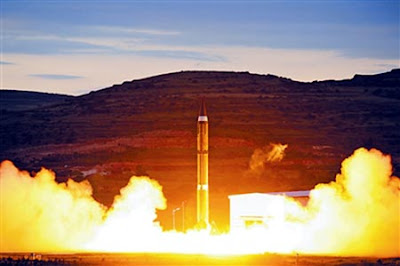China is believed to be developing a new DF-5B liquid-fuel missile that will be able to strike any target on the planet, reports our Chinese-language sister paper Want Daily.
The People’s Liberation Army’s current or in-development arsenal of long-range strategic intercontinental missiles (ICBMs) are led by the DF-31A, the DF-41 and the JL-2, all of which feature solid-fuel rockets.
The DF-31A, with a range of 10,000 kilometers, can reach the west coast of the United States. The DF-41 has a longer operational range of 12,000-15,000 kilometers and can carry three or more warheads, though the missile is still in the testing phase. The JL-2, which has an estimated operation of up to 8,000 km, can only be fired from a submarine at sea.
US and Japanese media report that China may have recently tested two ICMBs, the DF-41 and and the DF-5A. Military commentator Gao Feng believes that the firing of the DF-41 was part of regular testing, though the DF-5A test was likely part of basic research to develop a new liquid-fuel missile based on the DF-5 or the DF-5A.
According to Gao, though the DF-31A and the DF-41 are either in service already or nearing that stage, China should still have an interest in liquid-fuel missiles because of their significantly longer distances and higher load capacities. These advantages may be why Russia has recently announced that it is developing a new liquid-fuel missile based on its SS-18 ICBM.
Gao’s suggestion is also consistent with previous analysis of test images from Chinese media that China could be developing a brand new DF-5B liquid-propellant rocket. Compared to the DF-5A, the DF-5B will have an improved engine and superior precision and warheads. Reports indicate that the range will also be boosted to 13,000 km and 15,000 km, enabling the missile to cover the entire planet, while the load capacity will be upgraded to carry from four to six warheads.
The People’s Liberation Army’s current or in-development arsenal of long-range strategic intercontinental missiles (ICBMs) are led by the DF-31A, the DF-41 and the JL-2, all of which feature solid-fuel rockets.
The DF-31A, with a range of 10,000 kilometers, can reach the west coast of the United States. The DF-41 has a longer operational range of 12,000-15,000 kilometers and can carry three or more warheads, though the missile is still in the testing phase. The JL-2, which has an estimated operation of up to 8,000 km, can only be fired from a submarine at sea.
US and Japanese media report that China may have recently tested two ICMBs, the DF-41 and and the DF-5A. Military commentator Gao Feng believes that the firing of the DF-41 was part of regular testing, though the DF-5A test was likely part of basic research to develop a new liquid-fuel missile based on the DF-5 or the DF-5A.
 |
DF-5B liquid-fuel ICBM |
According to Gao, though the DF-31A and the DF-41 are either in service already or nearing that stage, China should still have an interest in liquid-fuel missiles because of their significantly longer distances and higher load capacities. These advantages may be why Russia has recently announced that it is developing a new liquid-fuel missile based on its SS-18 ICBM.
Gao’s suggestion is also consistent with previous analysis of test images from Chinese media that China could be developing a brand new DF-5B liquid-propellant rocket. Compared to the DF-5A, the DF-5B will have an improved engine and superior precision and warheads. Reports indicate that the range will also be boosted to 13,000 km and 15,000 km, enabling the missile to cover the entire planet, while the load capacity will be upgraded to carry from four to six warheads.




No comments:
Post a Comment